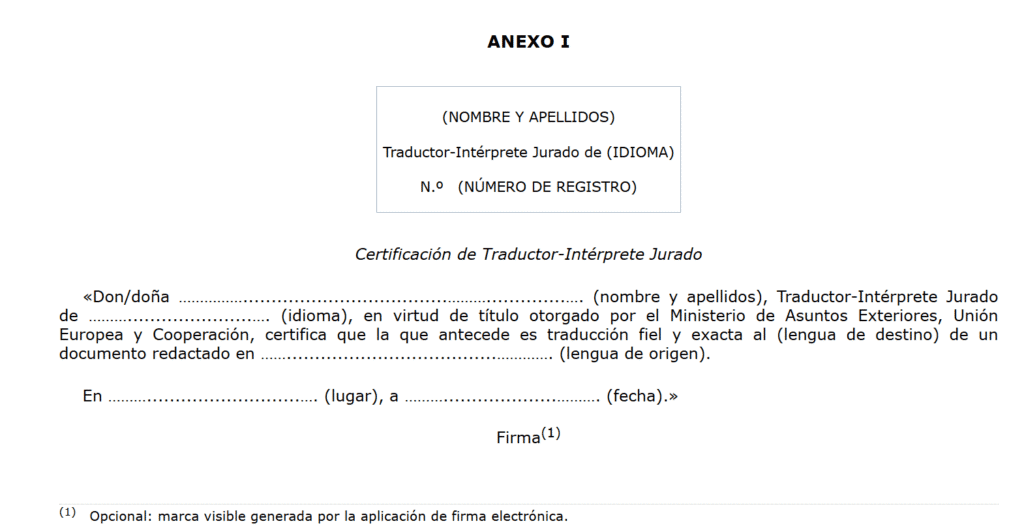On 26 February 2025, the Spanish Ministry of Foreign Affairs, European Union and Cooperation issued a Ministerial Order governing the use of an electronic signature for certifying Spanish sworn translations. This Order develops the provisions of Royal Decree 724/2020 of 4 August, which approved the Regulation of the Office of Language Interpretation (Oficina de Interpretación de Lenguas), and adapts certification procedures to the requirements of Regulation (EU) No 910/2014 on electronic identification and trust services (eIDAS), as amended by Regulation (EU) 2024/1183 establishing the European Digital Identity framework.
The explanatory memorandum highlights the objectives of the Order: to regulate the use of electronic signatures for the certification of Spanish sworn translations and interpretations, to replace the physical seal with a digital alternative, and to ensure compliance with principles of good regulation under the Spanish Administrative Procedure Act 39/2015. The Order has been reviewed by the Spanish Data Protection Agency, the State Legal Service, the IT and Communications Sub-Directorate, and the Ministry for Digital Transformation and Public Administration.
- Section 1 – Purpose
- Section 2 – Scope
- Section 3 – The Electronic Signature for Certifying Spanish Sworn Translations and Interpreting Assignments
- Section 4 – Using the Electronic Signature
- Section 5 – Protection of Personal Data
- Additional and Final Provisions
- Annexes – Certification Form
- Conclusion
- Practical Effect
Section 1 – Purpose
The Order governs the use of the electronic signature for the certification (‘jura’) of translations and interpreting by Spanish sworn translators and interpreters, making digitally-signed sworn translations fully valid for submission to Embassies, Consulates, academic institutions, civil registry offices, tax authorities and other public bodies.
Section 2 – Scope
It applies to all professionals who hold the official title of Spanish Sworn Translator, Sworn Interpreter or Sworn Translator-Interpreter issued by the Spanish Ministry of Foreign Affairs.
Section 3 – The Electronic Signature for Certifying Spanish Sworn Translations and Interpreting Assignments
- Spanish sworn translators and interpreters may certify the accuracy and truthfulness of their work by means of an electronic signature.
- The electronic signature must be made using a natural person’s qualified electronic certificate, in accordance with Articles 3.15 and 28 of Regulation (EU) No 910/2014, as amended by Regulation (EU) 2024/1183.
- The data of the certificate holder must match the information set out in the certification statement.
- A visual signature mark may be added, but it is optional and has no legal effect.
- The electronic signature must cover the entire document, including both the original text and the sworn translation. Preferred formats are PAdES (for PDFs) and CAdES (for other file types such as images, audio or video).
- Any application capable of generating these formats may be used. Validity can be checked at https://valide.redsara.es.
- Electronic certification may replace but does not invalidate the traditional handwritten signature and physical stamp, as provided for in Section 18 of Royal Decree 724/2020.
- Instead of the physical stamp, a text box must be inserted containing:
- Name and surname of the sworn translator or interpreter
- Authorised language(s)
- Registration number
- The certification and the text box must follow the legally prescribed form as set out in Annexes I–III.
- The sheet containing the text box and certification must also be signed electronically.
- For verifying the authenticity of originals:
- If the original is electronic, it may also be signed electronically.
- In interpreting tasks, the audio file and any transcript may be signed.
- Alternatively, the procedure in Section 18.5 of Royal Decree 724/2020 may be followed.
Section 4 – Using the Electronic Signature
The electronic signature may only be used in the performance of professional functions or in dealings with public authorities where such use is permitted.
Section 5 – Protection of Personal Data
- The processing of personal data will be strictly subject to the GDPR (Regulation (EU) 2016/679), Spain’s Organic Law 3/2018, and other applicable legislation.
- Only data necessary and proportionate to the purpose of certification may be processed.
- Data may not be disclosed to third parties or used for purposes other than those provided for in this Order.
Additional and Final Provisions
- Non-sexist language: all masculine-inclusive terms are deemed to apply equally to the feminine.
- Constitutional basis: the Order is issued under Article 149.1.18 of the Spanish Constitution (state competence in administrative procedure).
- Entry into force: the day following its publication in the Official Gazette of Spain (BOE).
Annexes – Certification Form
Annex I – Spanish Sworn Translator-Interpreter
Contains the certification template for sworn translators-interpreters, including mandatory fields: full name, language, registration number, certification statement, place and date, with optional visual signature mark.
In my case, my official appointment is ‘Spanish Sworn Translator-Interpreter’, so the formatting legally provided for my certification of Spanish sworn translations is as follows:

Annex II – Spanish Sworn Translator
Contains the certification template for sworn translators.
Annex III – Spanish Sworn Interpreter
Contains the certification template for sworn interpreters, including details of the interpretating event, place, time and date, and optional transcript.
Conclusion
This Ministerial Order represents a significant step forward in the digitalisation of sworn translation and interpretation in Spain. For Spanish sworn translators and interpreters, it provides a legally secure framework for the use of qualified electronic signatures, eliminating the need for a physical stamp while preserving the legal guarantees of accuracy and truthfulness. The reform modernises sworn translation practice, allowing for the full electronic production, certification, submission and verification of sworn translations and interpretations within the Spanish and European legal framework.
Practical Effect
- Sworn translators/interpreters will be able to fully certify translations electronically using a qualified digital certificate.
- The traditional stamp and handwritten signature are no longer mandatory when using a qualified electronic signature.
- Certification models (Annexes) have been adapted to the electronic environment.
Learn more on the advantages of digitally-signed Spanish sworn translations here, and specifically for visa applications, here.
If you need a digitally-signed sworn Spanish translation, contact me here.
LINKS
https://www.boe.es/diario_boe/txt.php?id=BOE-A-2025-4519
Did you like this post? Follow me on social media / ¿Te ha gustado este artículo? Sígueme en las redes sociales:
Sworn / Legal English-Spanish Translator with 20 years of experience in legal translation. BA in Translation & Interpreting and Graduate Diploma in English Law. Specialising in trusts, contracts, company documents and civil litigation documents. Traductora jurada y jurídica de inglés 20 años de experiencia en la traducción jurídica. Licenciada en Traducción e Interpretación y Graduada en Derecho inglés. Especializada en trusts, contratos, documentos societarios y escritos y documentos para procesos civiles y mercantiles.